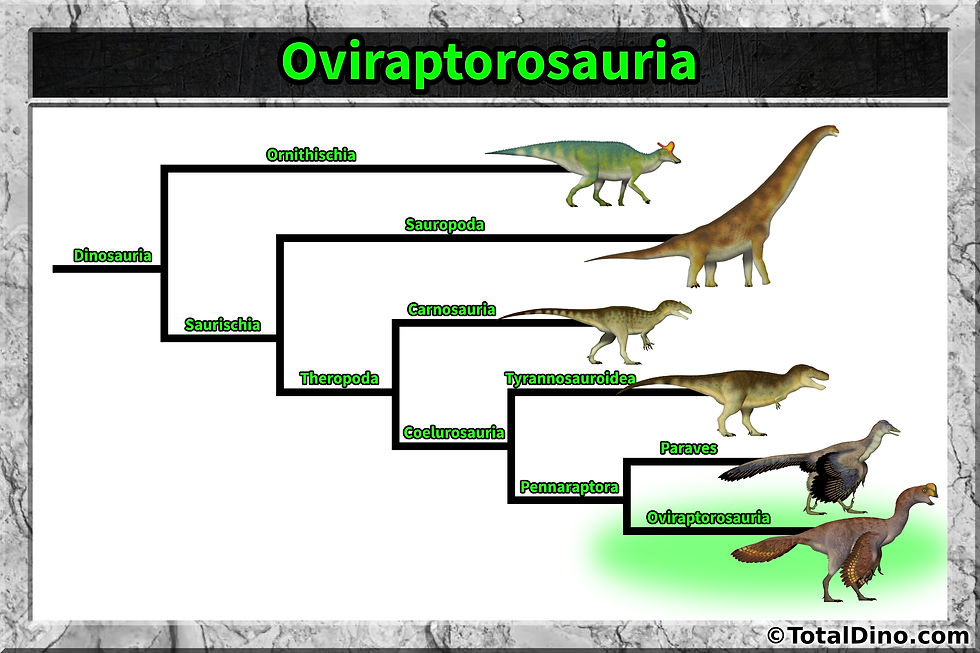Caudipteryx
- Total Dino
- Oct 20, 2024
- 2 min read
Updated: Sep 16
MEANING: Tail feather
PERIOD: Early Cretaceous
CONTINENT: Asia
Caudipteryx is a small feathered dinosaur with a stout trunk and long legs, indicating it was probably a swift runner. It was about 80 cm in length and weighed around 5 kg. The short feathers on its hands and tail indicate that it was flightless. The discovery of Caudipteryx has led to many studies and debate over the relationship of birds and dinosaurs.

Caudipteryx is from the Early Cretaceous. The Cretaceous is the third and final geological period of the Mesozoic Era, with the Early Cretaceous making up roughly the first half, lasting from about 143 to 100 million years ago. The poles were ice-free, due to the relatively warm climate, and forests extended into high latitudes. The continued breakup of the continents created new coastlines and isolated landmasses, influencing the evolution of distinct dinosaur faunas.
It was a time of transition, as many groups of animals and plants began to take on more modern forms while others declined or disappeared. Pterosaurs continued to thrive, though early birds were becoming more diverse and widespread. Mammals remained small but adapted to a variety of ecological niches. In the oceans, ichthyosaurs and plesiosaurs were common, and early mosasaurs began to appear.
Dinosaurs remained the dominant land animals, with groups like iguanodontians, spinosaurids, and carcharodontosaurids rising to prominence. While sauropods declined in some regions, they remained abundant in the Southern Hemisphere. The first true ceratopsians appeared, and ankylosaurs replaced stegosaurs in their niche. Dromaeosaurs and other small theropods diversified. During this time, the first flowering plants evolved, gradually changing global ecosystems by providing new food sources for herbivores.

Caudipteryx is an oviraptorosaur. Oviraptorosauria is a group of feathered theropod dinosaurs that lived during the Cretaceous Period and are known for their unusual, often bird-like anatomy. These dinosaurs were part of the larger clade Pennaraptora, which also includes birds, dromaeosaurs, and troodontids, and they show a mosaic of primitive and advanced traits that highlight their close relationship with birds.
Physically, oviraptorosaurs are characterized by their short, beaked snouts, often lacking teeth or bearing only a few reduced teeth at the front of the jaws. Many had elaborate cranial crests, which may have been used for display or species recognition. Their hands were relatively short but powerful, and their arms were often covered in feathers. Oviraptorosaurs were bipedal and typically had long legs suited for walking or running, with tails often stiffened by elongated vertebrae, possibly for balance or display. Fossils show that their plumage was not limited to basic fuzz but included complex feathering, similar to modern birds.
Oviraptorosaurs ranged in size from small species barely a meter long to much larger animals, including some over three meters in length. Their diet is still debated: some were likely herbivorous or omnivorous, using their strong, toothless beaks to process a variety of plant material, eggs, shellfish, or small animals. The discovery of nesting adults on top of egg clutches - some with embryonic remains inside - has given paleontologists valuable insight into their reproductive behavior, which appears to have been highly bird-like. Altogether, oviraptorosaurs offer a remarkable look at the diversity and evolutionary experimentation occurring within the feathered dinosaurs of the Cretaceous.





